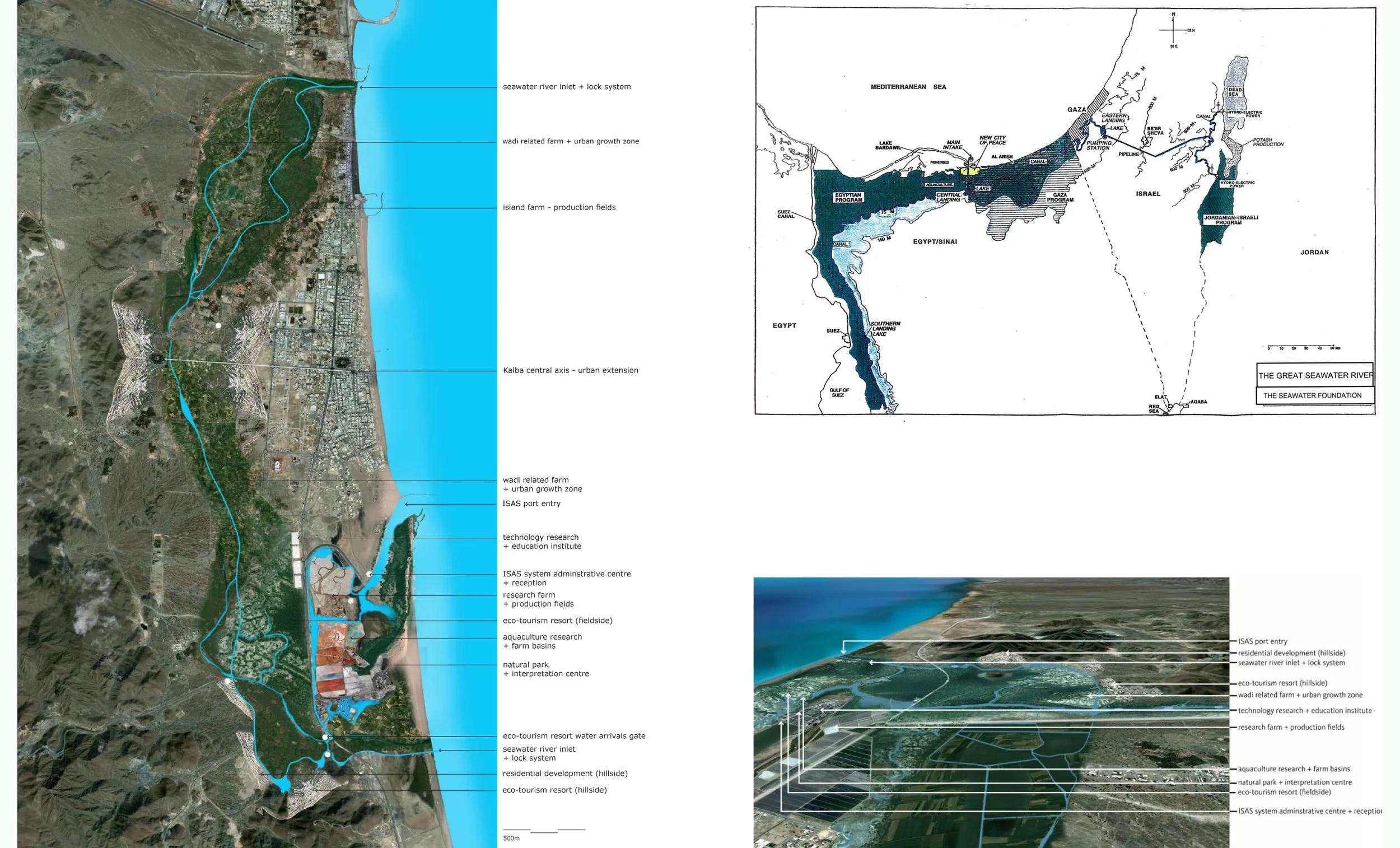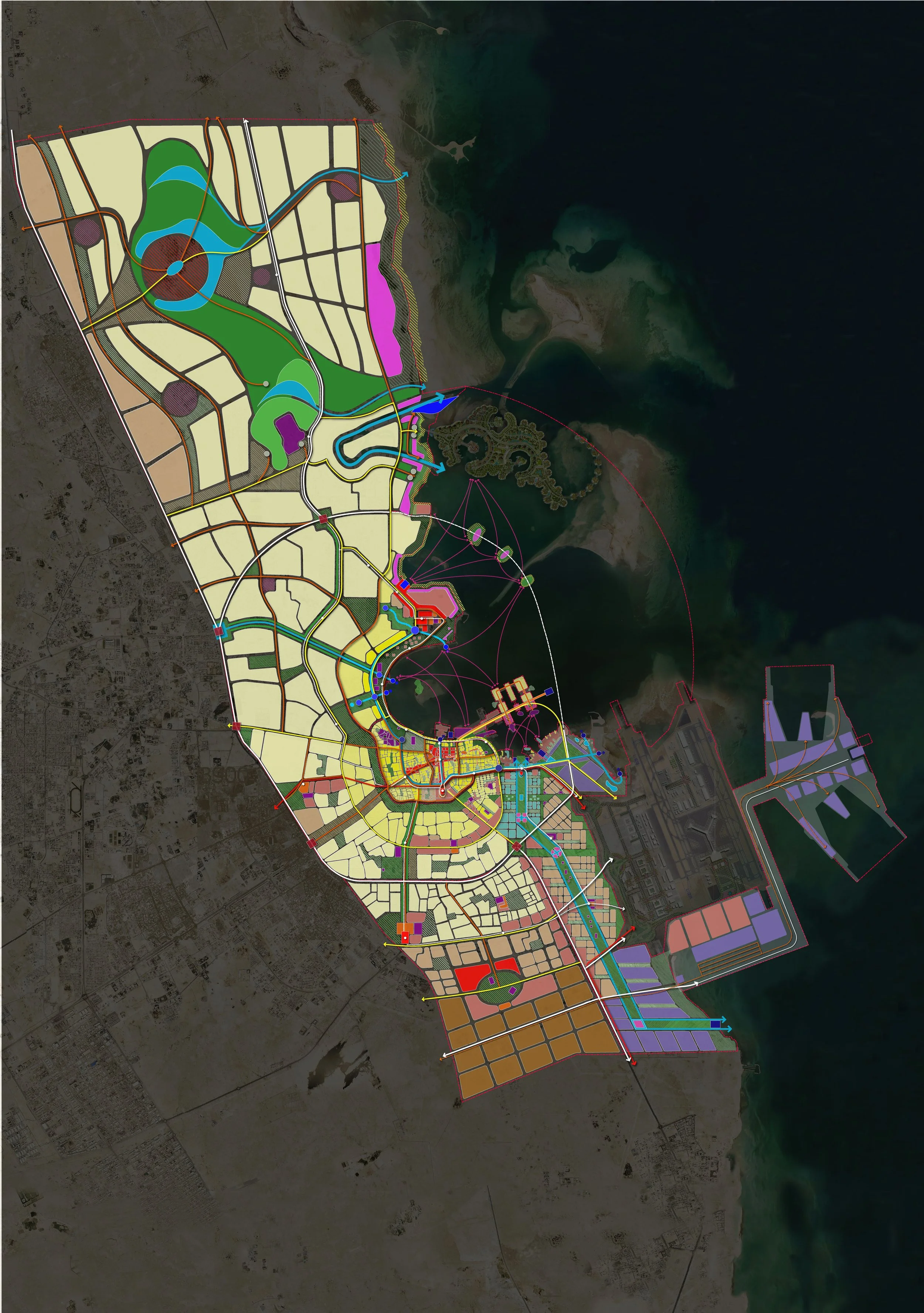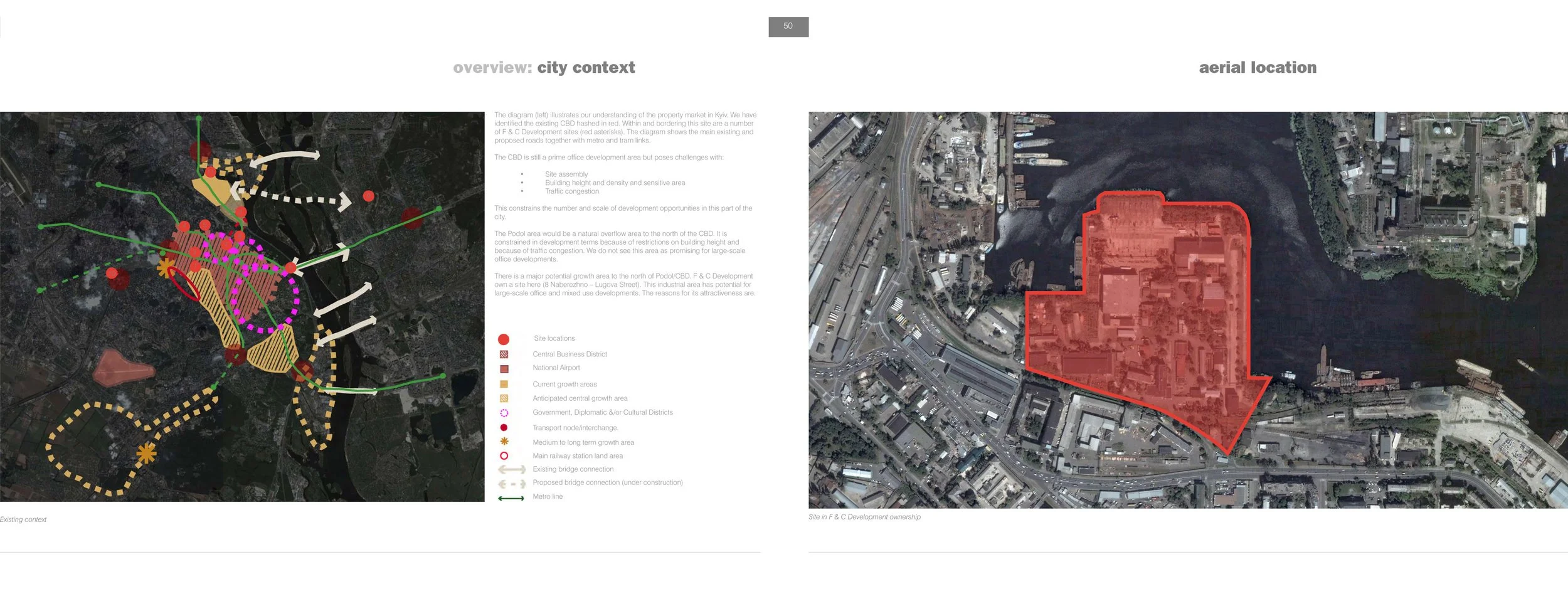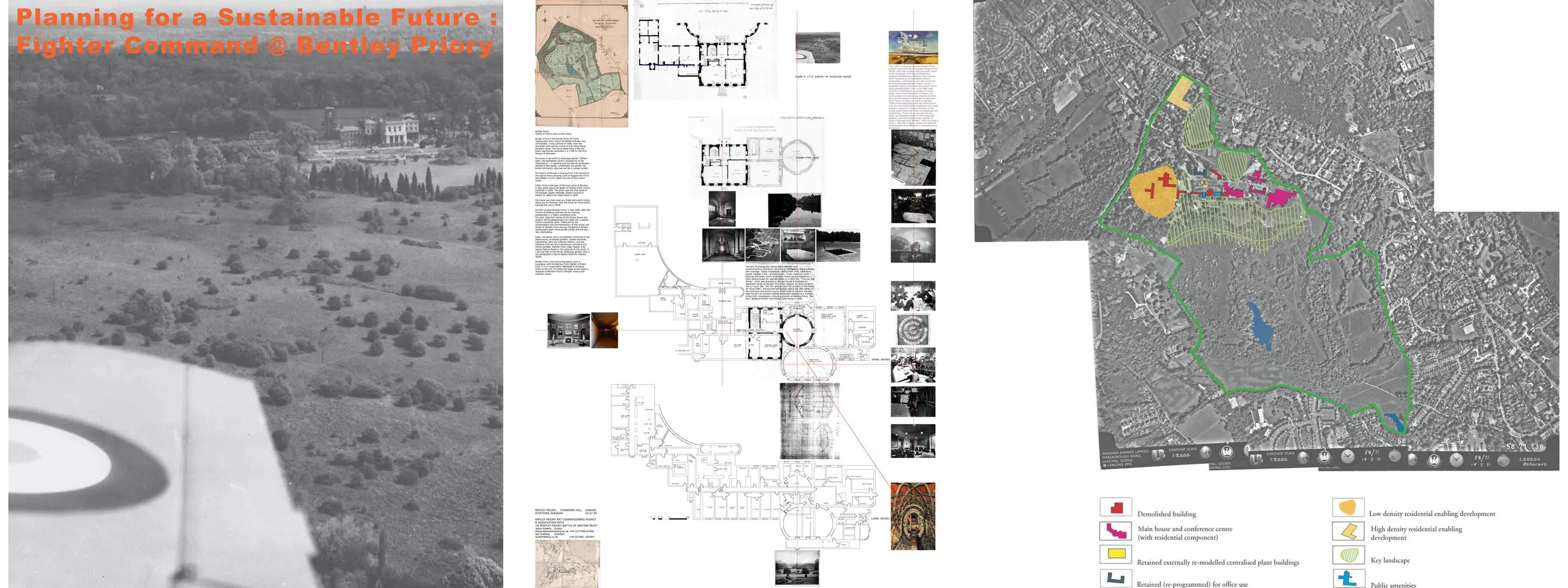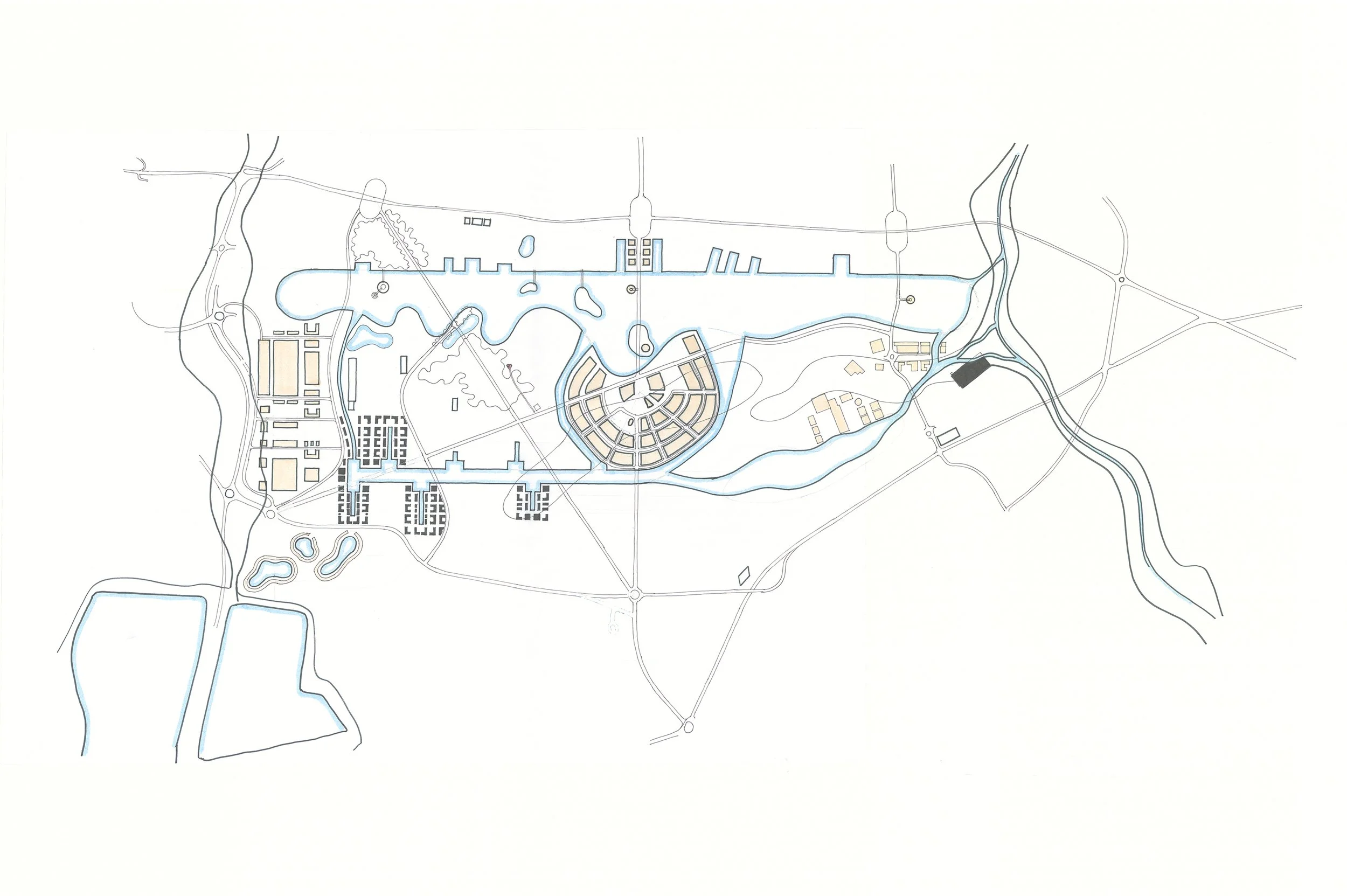
New London Borough for 250,000 people: Re-uses Heathrow Airport Infrastructure
Landscape concept & structure diagram (Site A, upper left diagram of project noted, below). The north and south runway concrete would be processed for re-utilisation elsewhere on site, and take the form of lakes and canals to sustainably manage the water table.
The Government’s Airports Commission (2013-15) formed the background for this study which centres on the creation of a new London Borough following relocation of Heathrow airport to a site in the Thames estuary. Two cities are proposed, at Heathrow, and on the Thames Estuary at Grain. The first would recuperate a lost landscape, transforming the fragmented Ballardian space which developed after late wartime requisition of agricultural land for an RAF airfield, and later installation of an international airport. The land had been used for wheat growing and market gardens which served London. This new London Borough would be formed from the repurposed airfield. Local civic centres would be connected to a social-ceremonial, administrative and commercial core, with housing set within a natural landscape park system. The airport’s vast aprons of concrete serve presently 536 aircraft movements each day, risking a catastrophic accident over London. The £55bn site development value (2015) would fund construction of a new airport in the relatively unfettered location of the Thames Estuary. This would generate well-connected homes for 250,000 people within the M25 motorway ring. This project would be visionary —and more fully transformational— in comparison with the £116bn public investment in HS2 rail, the economic case for which, according to Government Planning advisor, Sir Peter Hall, remained to be proven in 2014. The new City Borough at Heathrow forms a key part of the story of economic growth for the southeast in new town settlements, and a new international airport, lying between the UK and Europe, noted below.
Concept Plan for Area 1 Doha, Planning Study
This concept plan for Area 1, Doha, was undertaken for the City Planning Authority, with Arup Economics and Transport, in 2005. Research and interviews with a number of cultural, economy, planning and tourism administrations led to identification of the historic city centre as site for cultural and economic reinvestment, linked to outlying neighbourhoods. My report on the historic centre was used to develop the following project for The Heart of Doha. *
Kyiv City Strategy, Ukraine
Arab Centre for Research & Policy Studies - Doha Institute for Graduate Studies, Doha
Kalba, Oman; coastal edge farming system and housing complex for biofuel production
St. Petersburg City Extension, Vasilievskiy Island, Russian Federation
New City, Isle of Grain, Thames Estuary
This concept for a new city was submitted as candidate for the Wolfson Economics Prize. It proposes a position in the landscape for a city at a strategic level of principle. The following stages would develop detail of how up to 80,000 people —Aristotle stipulates no more than this figure for a city in Politics— would live and work in a neighbourhood system of sub-centres and core. Cultures of living —and citizen health— would be nurtured in balanced development form, at densities which vitalise public inter-activity. The ecologies of the natural estuary landscape and urban space would inter-twine, and connect to national transport infrastructure following revitalisation of a decommissioned Beeching-era railway line. Employment, health and social performance ambitions invite this proposal in support of the dis-invested Kent economy and sustainable growth of the London region. This plan forms part of the narrative for a new international airport in the Thames estuary, an echo of the 1970s project for a new London airport at Maplin. That plan included a new city for 600,000 people, connected to the centre of London by high speed rail. Construction of the airport was begun, only to be cancelled by an incoming Government in the aftermath of the 1973 Arab-Israeli war and following oil crisis. The new city at Grain would form one of a network of other small cities, similarly connected to national rail infrastructure, including those built upon new islands in the Estuary proposed for unnavigable areas of water.
Concept: The inspiring Thames Estuary Landscape. The town would rest on a land portal, witness to the elegiac flow of Britain’s trading and cultural exchange, and thus, a significant history.
One ambition of the plan is to reserve Green Belt land across the country, saving it from a rash of unsustainably dysfunctional low density housing development that is poorly served by public transport. Such a dense conurbation —distinct from low density Green Belt sprawl—would allow high levels of employment, service, social and cultural life, and desirable new environments for living. I researched the background, laid out the plan and authored the submission with text on economics from Bridget Rosewell and Hugh Mulcahey and planning from Ian Mulcahey, for Gensler.
Portsmouth, New Housing Extension
Research and report for City of Portsmouth plan for new housing. *
Planning & Urban Design
A selection of international as well as UK design experience is shown below, including for St. Petersburg, Russian Federation, Doha, Qatar, Oman, Baku, Azerbaijan, Kyiv, Ukraine, and Lesvos, Greece
The plan is based upon a La Defence, Paris-like concept to enhance the identity of the UNESCO protected city, allowing concentration of large scale buildings at remove from St. Petersburg’s sensitive urban core. A new Marine Facade image of St. Petersburg would be formed on the western sea approach by a composition of tall buildings and twin bridge pylon infrastructure serving the Western Diameter Highway ring. In concept, the bridge pylons stand as analogues to the historic landmark Rostral columns marking the east of the island nearly opposite the State Hermitage Museum.
The forty strong St. Petersburg City Planning & Architecture Committee awarded concept planning approval on first hearing for this city extension for 80,000 people on land claimed from the Gulf of Finland. They commended the design, “this is a beautiful plan”, and let us know they had rejected a competitor plan on thirteen occasions for a similar scale old dockyard site nearby. I led research and concept design, laying out the plan with local team advise from the former city architect and urban historian. ((*) = for Int’l practice Gensler))
Eco-tourism Resort, Lesvos, Greece, The Rubinstein Organisation
Global Seawater, Inc. (GSI) was formed in February 2007 with the vision of making a significant contribution to the World’s energy and food needs using the most abundant natural resource, seawater, to “bring life to the desert”, green desert coastlands, and build sustainable communities. Straightforward low technology water pumping irrigation systems allow conventionally unproductive land areas for sustainable seawater agriculture. This enables production of samphire commodities including oilseeds for edible oil products, oil for other applications, including meal for human and animal needs, and forage / hay for animal feed. Seawater aquaculture integrated to samphire growth provides natural closed-cycle nutrition with commercial production of shrimp and fish.
I led the design team laying out this concept plan for a salicornia and shellfish farming community at Kalba, Oman, for the founding director of the Environmental Research Laboratory at the University of Arizona, innovator for climate change solutions, Dr. Carl Hodges, and his colleagues.
The plan responds to local topography and the historic co-ordinates of the town at Kalba. New bio-technology research institutions, a satellite town for research and farm workers, and an eco-resort, are laid out in harmonious relation to the wider local community. The plan suggests strategic locations for housing, retail shopping, schools, cultural facilities and landscape parks.
Dr. Hodges’ Seawater Foundation and GSI Initiative had developed trial coastal edge community projects in the USA, Abu Dhabi, Eritrea, along the Red Sea, Egypt and Saudi Arabia. * The image, below right, is of The Foundation’s precursor (to Kalba) 1995 Cradle II and Saltwater River peace project. This would connect the Mediterranean to the Dead Sea to support the economy of Palestine, Israel and Egypt Sinai, and rebalance the Dead Sea ecosystem. The initiative was conducted with the support of Dr. Hanan Ashrawi, Marlon Brando and Shimon Peres’ office, until the assassination of Prime Minister Yitzhak Rabin.
HRH The Emir’s Private Engineering Office (PEO, Doha) and the local Planning Authority gave concept plan approval for The Arab Centre for Research and Policy Studies (ACRPS) and Doha Institute, an academic research campus for 500 social research Phd students. The project is sponsored by HRH The Emir of Qatar for Director, Dr. Azmi Bishara, a former Member of Parliament in Israel, and respected figure in regional political and cultural affairs. I conducted research and led concept design assisted by a talented team of colleagues.
Ancient orders and scale of non-directional space, community form, gardens and watercourses are reinterpreted in the plan. The complex at first appears walled at varying inclines and angles of slope, yet openings are incised. These allow different access ways, and they induce air movement to temper the environment. The complex is a view-finding mechanism. A film-like panorama of the centre is glimpsed through openings in earth-berm walls. As for film-making and the process of montage, cuts in the wall give access to an open place for free thinking. The research centre is a new forum. It invites assembly and projection of new ideas to the world outside.
The distinguished scholar, Professor Aziz Al-Azmeh, described The Arab Centre for Research and Policy Studies as the “premier barometer of the region” in a recent talk at The London School of Economics , Freethinking, Secularism and the Arab Spring. I worked with Dr. Bishara and his advisors including his construction management lead, Omar Jamali, IBE Partnership. The complex was constructed immediately to the north on a less constrained site. Hanif Kara (AKTII) and Patrick Bellew (Atelier 10) gave structural and environmental design advice. A year after approvals, the PEO invited submission of a concept design for the Emir’s new palace complex at the heart of the city. This came after work on the concept plan for Area 1, Doha, in 2005, for the City Planning Authority, with Arup Economics and Transport Engineers, which identified the historic city centre as site for cultural and economic reinvestment. *
This study was undertaken for a Parliamentarian to help strategise the redevelopment of a number of obsolescent industrial and other central city sites. Concept studies followed city research visits, allowing production of supplementary planning guidance-like strategy plans. The scale of the projects ranged from historic centre city civic and residential buildings to a monumental Dnieper river dockyard complex. *
Sustainable plan for the L.B. Harrow for Grade II* listed Sir John Soane house and landscape park, in 1940, the command and control centre for The Battle of Britain. *
RAF Bentley Priory, Stanmore Hill, London
Competition research and study plan for sustainable tourism resort on Lesvos, Greece. *



